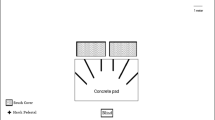Abstract
Although often described, the function of wing-flashing behavior in Northern mockingbirds remains unknown. One group of hypotheses proposes it is related to foraging, while another non-exclusive set of hypotheses proposes that it is an expression of intra- or interspecific hostility. Based on new observations, and after reviewing the literature, we suggest that intense wing-flashing is performed by breeding adults when confronted with a predator, although cannot exclude any foraging enhancement function. Because similar behavior has been described in many mimid (Mimidae) species, and because oxpeckers (Buphagidae) are the ancestral group to mimids, we propose that wing-flashing in mimids is ancestral, and that the oxpecker’s open-wing display would be a precursor to wing-flashing.
Similar content being viewed by others
References
Allen FH (1947) The mockingbird’s wing-flashing. Wilson Bull 59:71–73
Batts HL Jr (1962) Wing-flashing motions in a catbird. Auk 79:112–113
Brackbill H (1951) Wing-flashing by male mockingbirds. Wilson Bull 63:204–206
Burtt EH, Swanson JA, Porter BA, Waterhouse SM (1994) Wing-flashing in mockingbirds of the Galapagos Islands. Wilson Bull 106:559–562
Derrickson KC, Breitwisch R (1992) Northern mockingbird. In: Poole A, Stettenheim P, Gill F (eds) The birds of North America. The Academy of Natural Sciences, Philadelphia; The American Ornithologists’ Union, Washington, DC. doi:102173/bna7
Gander FF (1931) May the color pattern of the mockingbirds wings aid in finding insect food? Wilson Bull 43:146
Halle LJ (1948) The Calandria mockingbird flashing its wings. Wilson Bull 60:234
Hailman JP (1960a) Insects available for a mockingbird wing-flashing in February. Condor 62:405
Hailman JP (1960b) A field study of the mockingbirds wing-flashing behavior and its association with foraging. Wilson Bull 72:346–357
Haverschmidt F (1953) Wing-flashing of the graceful mockingbird Mimus gilvus. Wilson Bull 65:52
Haverschmidt F (1962) Wing-flashing of graceful mockingbird while assembling sticks. Wilson Bull 74:97
Hayslette SE (2003) A test of the foraging function of wing-flashing in Northern mockingbirds. Southeast Nat 2:93–98
Hicks TW (1955) Mockingbird attacking blacksnake. Auk 72:296–297
Horwich RH (1965) An ontogeny of wing-flashing in the mockingbird with reference to other behaviors. Wilson Bull 77:264–281
Hundley MH (1963) Wing-flashing in the Galápagos mockingbird. Auk 80:372
Lovette IJ, Rubenstein DR (2007) A comprehensive molecular phylogeny of the starlings (Aves: Sturnidae) and mockingbirds (Aves: Mimidae): congruent mtDTA and nuclear trees for a cosmopolitan avian radiation. Mol Phylogenet Evol 44:1031–1056
Michael ED (1970) Wing flashing in a brown thrasher and catbird. Wilson Bull 82:330–331
Michener H , Michener JR (1935) Mockingbirds, their territories and individualities. Condor 37:97–140
Sargent GT (1940) Observations on the behavior of color-banded California thrashers. Condor 42:49–60
Selander RK, Hunter DK (1960) On the functions of wing-flashing in mockingbirds. Wilson Bull 72:341–345
Stutterheim CJ (1982) Breeding biology of the redbilled oxpecker in the Kruger National Park. Ostrich 53:79–90
Sutton GM (1946) Wing-flashing in the mockingbird. Wilson Bull 58:206–209
Tomkins IR (1950) Notes on wing-flashing in the mockingbird. Wilson Bull 62:41–42
Wampole JH (1949) Two observations of wing-flashing by mockingbirds. Wilson Bull 61:113
Whitaker LM (1957) Comments on wing-flashing and its occurrence in Mimidae with uniformly colored wings. Wilson Bull 69:361–363
Acknowledgments
We thank Irby Lovette, S.E. Hayslette and an anonymous reviewer for their constructive comments.
Author information
Authors and Affiliations
Corresponding author
About this article
Cite this article
Dhondt, A.A., Kemink, K.M. Wing-flashing in Northern mockingbirds: anti-predator defense?. J Ethol 26, 361–365 (2008). https://doi.org/10.1007/s10164-007-0070-z
Received:
Accepted:
Published:
Issue Date:
DOI: https://doi.org/10.1007/s10164-007-0070-z




